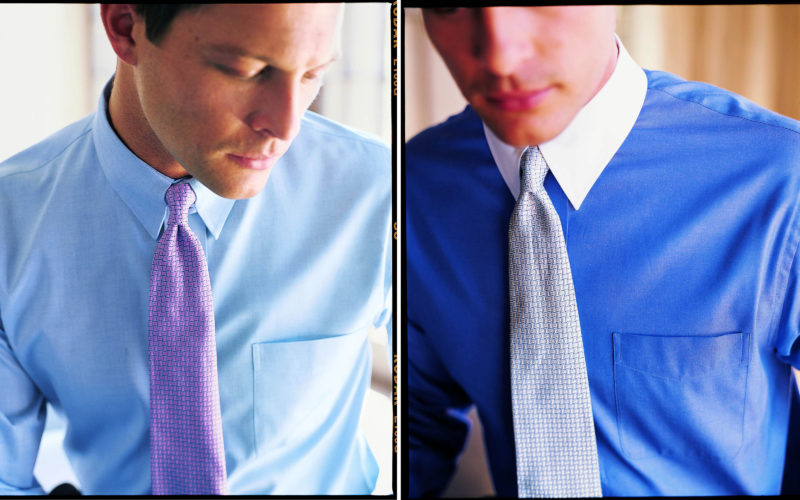Q. I attended a conference a year or so ago; it was not about style, but the keynote speaker spoke about dress shirts. He talked about white shirts’ representing old school authority (my words not his, but that’s the way I remember it.) That stuck with me but he also talked about colored and striped shirts and who wore them, and I don’t remember what he said, something about how different generations see things differently. Can you provide any insight on this?
A. I agree that men’s dress shirts do tend to say a lot about the wearer. Not only the color of the shirts, but also the pattern, fabric, cut, collar, and how they are worn. The elements work together to make statements about the wearer, and they should suit the formality of the setting. Let me break that down by each category
COLOR – In almost all cases, the most conservative color choice is white. It is never “wrong.” Because this is so, white shirts often do tend to suggest Old School authority. A close second in formality is the versatile blue shirt; but here, there is a tremendous amount of variation. Light shades of blue are quietly traditional, as are many medium blues; darker blues are more informal and generally more correct as casual wear.
Still quite conservative are solid off-white/ivory shirts (and shirts with narrow blue-and-white stripes). Moving down the formality scale are shades of light pink, soft yellow, and the newly popular pale purple. Even so, it is rare to see older, conservative men wearing any shade of purple
More stylish, younger, and informal dressers enjoy expanding their color horizon by wearing a variety of colored shirts. Darker and more vividly-colored shirts are less dressy. Neutral-colored shirts in gray, tan, and khaki have a dressed-down vibe, and are probably best avoided in smart business and social attire.
PATTERN – Patterned shirts are more casual than solids. Of all the dress shirt patterns, stripes are the most popular. The narrower the stripe, the dressier and more traditional the shirt. Wider and brighter-colored stripes make a shirt more informal (bold Bengal stripes are an example). In addition to stripes, handsome, small shirting patterns include tattersalls, herringbones, and gingham checks. Such patterns as polka dots, large checks, plaids, and Hawaiian florals only work well as sport shirts. They are too flashy to be appropriate business dress shirts.
FABRIC – The shirt fabric of choice is 100% cotton. The more you can see the texture of the fabric, generally the less formal. Shirt fabrics/textures range from the dressiest – such as smooth broadcloth and fine pinpoint Oxford cloth – to less formal – standard Oxford cloth and end-on-end weave – on to the most casual – chambray and denim. But denim is too rugged to qualify as a dress shirt, even for a young, cool guy.
CUT – The full fit of Brooks Brothers’ yesteryear shirts are more traditional, but currently they are verging on out-of-style. Today’s versions are still slightly full, but not so parachute-like. Slim-fits and extra-slim-fits are more casual, and also more modern. Even so, that does not necessarily make them age-appropriate (or flattering) for everyone. About French cuffs: they are dressier than barrel (button) cuffs. While all French-cuff shirts are dress shirts, not all dress shirts have French cuffs. And, of course, a dress shirt always has long sleeves.
COLLARS – This may be the element that most distinctively separates wearers. Traditional/preppy dressers are mostly (only?) comfortable wearing softly-rolled button-down collars. These are men in academia and other Ivy League types, as well as older guys. Many younger men and fashion-forward dressers wear straight-point and/or spread collars most of the time, limiting their choice of button-downs to casual weekend dressing. The wider the collar spread, the dressier and more flamboyant the look. Also, the wider the spread, the less appropriate the shirt is for wearing open-at-the-neck without a tie. It is my strong opinion that a button-down collar should always be worn buttoned; else, why choose it?
You remembered the keynote’s comment about white shirts because it made sense and stands the test of time. The same cannot always be said about fashion magazines. These days, a lot of what you see in them may not be the best advice for the right dress shirt to wear in a traditional work setting . . . or, often, anywhere outside their pages.
Please send your men’s dress and grooming questions and comments to MALE CALL: Lois.Fenton@prodigy.net









